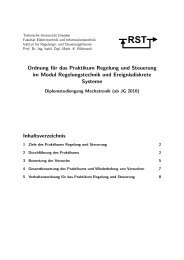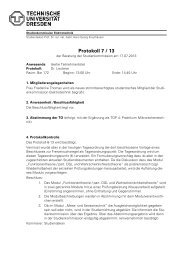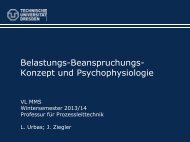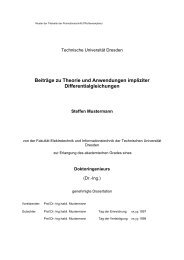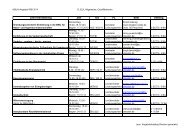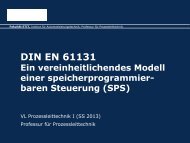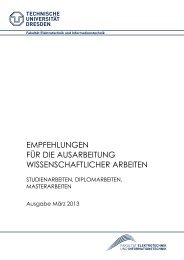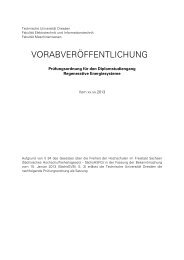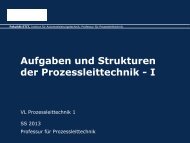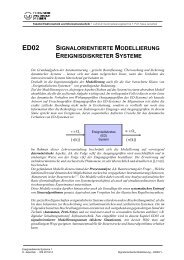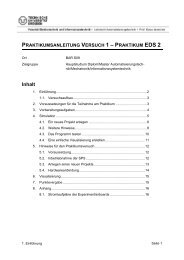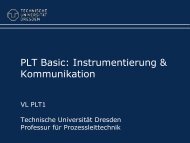fuzzy system
fuzzy system
fuzzy system
Create successful ePaper yourself
Turn your PDF publications into a flip-book with our unique Google optimized e-Paper software.
Fakultät ETIT Institut für Automatisierungstechnik, Professur für Prozessleittechnik<br />
26.01.2010<br />
Dr. Engin YEŞİL<br />
Introduction to<br />
Fuzzy Modeling & Control
Fuzzy Systems:<br />
•<br />
•<br />
A static or dynamic <strong>system</strong> which makes use of <strong>fuzzy</strong><br />
sets or <strong>fuzzy</strong> logic and of the corresponding<br />
mathematical framework is called a <strong>fuzzy</strong> <strong>system</strong>. <strong>system</strong><br />
There are a number of ways <strong>fuzzy</strong> sets can be<br />
involved in a <strong>system</strong>, such as:<br />
1. In the description of the <strong>system</strong>,<br />
2. In the specification of the <strong>system</strong>’s parameters,<br />
3. The input, output and state variables of a <strong>system</strong> may<br />
be <strong>fuzzy</strong> sets.<br />
Folie 2
1.<br />
•<br />
•<br />
In the description of the <strong>system</strong>:<br />
A <strong>system</strong> can be defined, for instance, as a collection<br />
of IF-THEN IF THEN rules with <strong>fuzzy</strong> predicates, or as a <strong>fuzzy</strong><br />
relation.<br />
An example of a <strong>fuzzy</strong> rule describing the relationship<br />
between a heating power and the temperature trend<br />
in a room may be:<br />
If the heating power is high<br />
then the temperature will increase fast<br />
Folie 3
2.<br />
•<br />
In the specification of the <strong>system</strong>’s parameters:<br />
The <strong>system</strong> can be defined by an algebraic or<br />
differential equation, in which the parameters are<br />
<strong>fuzzy</strong> numbers instead of real numbers.<br />
“Almost<br />
3”<br />
“About<br />
3 5<br />
•Fuzzy numbers express the uncertainty in the<br />
parameter values.<br />
5”<br />
Folie 4
3.<br />
•<br />
•<br />
The input, output and state variables of a <strong>system</strong><br />
may be <strong>fuzzy</strong> sets:<br />
Fuzzy inputs can be readings from unreliable sensors<br />
(“noisy” data), or quantities related to human<br />
perception, such as comfort, beauty, etc.<br />
Fuzzy <strong>system</strong>s can process such information, which is<br />
not the case with conventional (crisp) <strong>system</strong>s.<br />
Folie 5
Crisp and <strong>fuzzy</strong> information in <strong>system</strong>s<br />
Folie 6
Fuzzy Systems<br />
•<br />
•<br />
•<br />
Fuzzy <strong>system</strong>s can be regarded as a generalization of<br />
interval-valued <strong>system</strong>s, which are in turn a<br />
generalization of crisp <strong>system</strong>s.<br />
Note that a function f:XY can be regarded as a<br />
subset of the Cartesian product X x Y , i.e., as a<br />
relation.<br />
The evaluation of the function for a given input<br />
proceeds in three steps:<br />
1. extend the given input into the product space X x Y<br />
2. find the intersection of this extension with the<br />
relation,<br />
3.project this intersection onto Y.<br />
Folie 7
crisp function<br />
interval function<br />
<strong>fuzzy</strong> function<br />
Folie 8
•<br />
•<br />
•<br />
•<br />
Fuzzy Systems<br />
Most common are <strong>fuzzy</strong> <strong>system</strong>s defined by means of<br />
if-then rules: rule-based <strong>fuzzy</strong> <strong>system</strong>s.<br />
In the rest of this lecture we will focus on these<br />
<strong>system</strong>s only.<br />
Fuzzy <strong>system</strong>s can serve different purposes, such as<br />
– modeling,<br />
– data analysis,<br />
– prediction or<br />
– control.<br />
Here, a <strong>fuzzy</strong> rule-based <strong>system</strong> is for simplicity called<br />
a <strong>fuzzy</strong> model, model regardless of its eventual purpose.<br />
Folie 9
Input<br />
Scaling<br />
Factor<br />
Components of a Fuzzy Systems<br />
CRISP<br />
Fuzzifier<br />
Fuzzy Rule-Base<br />
Fuzzy<br />
Inference<br />
Engine<br />
FUZZY FUZZY<br />
Defuzzifier<br />
CRISP<br />
Output<br />
Scaling<br />
Factor<br />
Folie 10
•<br />
•<br />
•<br />
In <strong>fuzzy</strong> <strong>system</strong>s, the relationships between variables are<br />
represented by means of <strong>fuzzy</strong> “IF-THEN” rules of the<br />
following general form:<br />
IF antecedent proposition<br />
THEN consequent proposition<br />
The antecedent proposition is always a <strong>fuzzy</strong> proposition of<br />
the type “x is A” where x is a linguistic variable and A is a<br />
linguistic term.<br />
The proposition’s truth value (a real number between zero<br />
and one) depends on the degree of match (similarity)<br />
between x and A.<br />
Folie 11
•<br />
<br />
<br />
<br />
<br />
Depending on the form of the consequent, four types of<br />
rule-based <strong>fuzzy</strong> models are distinguished:<br />
Mamdani (Linguistic) <strong>fuzzy</strong> model,<br />
Singleton <strong>fuzzy</strong> model,<br />
Takagi-Sugeno (T-S) <strong>fuzzy</strong> model,<br />
(Tsukamoto <strong>fuzzy</strong> model).<br />
Folie 12
•<br />
Mamdani (Linguistic) <strong>fuzzy</strong> model:<br />
The linguistic <strong>fuzzy</strong> model (Zadeh, 1973; Mamdani, 1977)<br />
has been introduced as a way to capture available (semi-)<br />
qualitative knowledge in the form of if–then rules:<br />
The input<br />
(antecedent)<br />
linguistic variable<br />
The antecedent<br />
linguistic terms<br />
The consequent<br />
linguistic terms<br />
The output (consequent)<br />
linguistic variable<br />
Folie 13
More examples?<br />
•<br />
•<br />
•<br />
•<br />
If<br />
the pressure is HIGH then<br />
If you are CLOSE to the other car then<br />
If the room is VERY COLD then<br />
to FULL<br />
the volume is SMALL<br />
brake is MAX<br />
switch on the heater<br />
If the error is ZERO and the change of the error is<br />
ZERO then the change in control signal is ZERO<br />
Folie 14
•<br />
•<br />
•<br />
Fuzzy logic operators, such as the conjunction,<br />
disjunction and negation (complement), can be used to<br />
combine the propositions.<br />
A MIMO model can be written as a set of MISO models.<br />
Therefore, for the ease of notation, we will write the<br />
rules for MISO <strong>system</strong>s.<br />
Most common is the conjunctive form of the antecedent,<br />
which is given by:<br />
Folie 15
Example<br />
Max-min composition<br />
R1<br />
R2<br />
R3<br />
: If X is small then Y is small<br />
: If X is medium then Y is medium<br />
: If X is large then Y is large<br />
and centroid<br />
X = input [10, 10]<br />
Y = output [0, 10]<br />
defuzzification were used.<br />
Overall input-output curve<br />
Folie 16
Example<br />
Max-min composition<br />
X,<br />
Y,<br />
Z <br />
[5, 5]<br />
R1: If X is small and Y is small then Z is negative large<br />
R2: If X is small and Y is large then Z is negative small<br />
R3: If X is large and Y is small then Z is positive small<br />
R4: If X is large and Y is large then Z is positive large<br />
and centroid<br />
defuzzification were used.<br />
Overall input-output curve<br />
Folie 17
•<br />
•<br />
Singleton <strong>fuzzy</strong> model:<br />
A special case of the linguistic <strong>fuzzy</strong> model is obtained<br />
when the consequent <strong>fuzzy</strong> sets Bi are singleton <strong>fuzzy</strong><br />
sets.<br />
These sets can be represented simply as real numbers,<br />
yielding the following rules:<br />
Folie 18
•<br />
•<br />
Takagi-Sugeno <strong>fuzzy</strong> model:<br />
The Takagi–Sugeno (T-S) <strong>fuzzy</strong> model (Takagi and<br />
Sugeno, 1985), uses crisp functions in the consequents.<br />
Hence, it can be seen as a combination of linguistic and<br />
mathematical regression modeling in the sense that the<br />
antecedents describe <strong>fuzzy</strong> regions in the input space in<br />
which consequent functions are valid. The T-S rules have<br />
the following form:<br />
Folie 19
•<br />
•<br />
The functions fi are typically of the same structure, only<br />
the parameters in each rule are different.<br />
Generally, fi is a vector-valued function, but for the ease of<br />
notation we will consider a scalar fi in the sequel. A simple<br />
and practically useful parameterization is the affine (linear<br />
in parameters) form, yielding the rules:<br />
What happens when a i is ZERO?<br />
Folie 20
60<br />
50<br />
40<br />
30<br />
20<br />
10<br />
0<br />
1.2<br />
1<br />
0.8<br />
0.6<br />
0.4<br />
0.2<br />
f 2(x)<br />
How do you define this function?<br />
f 1(x)<br />
0 1 2 3 4 5 6 7<br />
Small Big<br />
0<br />
0 1 2 3 4 5 6 7<br />
RULE 1:<br />
IF x is Small<br />
RULE 2:<br />
IF x is Big<br />
THEN y(x)=f1(s) THEN y(x)=f2(s) Folie 21
Example<br />
R1: If X is small then Y = 0.1X + 6.4<br />
R2: If X is medium then Y = 0.5X + 4<br />
R3: If X is large then Y = X – 2<br />
X = input <br />
unsmooth<br />
[10, 10]<br />
Folie 22
Example<br />
R1: If X is small then Y = 0.1X + 6.4<br />
R2: If X is medium then Y = 0.5X + 4<br />
R3: If X is large then Y = X – 2<br />
X = input [10, 10]<br />
If we have smooth membership functions (<strong>fuzzy</strong> rules) the<br />
overall input-output curve becomes a smoother one.<br />
Folie 23
Example<br />
X, Y [5, 5]<br />
R1: if X is small and Y is small then z = x +y +1<br />
R2: if X is small and Y is large then z = y +3<br />
R3: if X is large and Y is small then z = x +3<br />
R4: if X is large and Y is large then z = x + y + 2<br />
Folie 24
What defines the size of the rule-base?<br />
An example:<br />
# of inputs 3: A, B, C<br />
# of outputs 1: D<br />
# of membership functions for each inputs:<br />
• A 5<br />
• B 3<br />
• C 4<br />
How many rules do you need?<br />
Folie 25
MIMO -<br />
•<br />
MISO<br />
Note that the above model is a special case of<br />
as the <strong>fuzzy</strong> set Ai in (1) is obtained as the Cartesian<br />
product of <strong>fuzzy</strong> sets.<br />
Folie 26
•<br />
•<br />
•<br />
A set of rules in the conjunctive<br />
antecedent form divides the input<br />
domain into a lattice of <strong>fuzzy</strong><br />
hyperboxes, parallel with the axes.<br />
Each of the hyperboxes is an Cartesian<br />
product-space intersection of the<br />
corresponding univariate <strong>fuzzy</strong> sets.<br />
The number of rules in the conjunctive<br />
form, needed to cover the entire<br />
domain.<br />
K<br />
<br />
<br />
p<br />
i1<br />
p is the dimension of the input space, and Ni is the number of linguistic<br />
terms of the ith antecedent variable.<br />
N<br />
i<br />
Folie 27
•<br />
•<br />
By combining<br />
– conjunctions,<br />
– disjunctions,<br />
– negations<br />
various partitions of the antecedent<br />
space can be obtained.<br />
The boundaries are, however,<br />
restricted to the rectangular grid<br />
defined by the <strong>fuzzy</strong> sets of the<br />
individual variables.<br />
<br />
β <br />
1<br />
μ A ( x1<br />
) μ A ( x 2 )<br />
13 21<br />
<br />
Folie 28
•<br />
•<br />
•<br />
•<br />
The antecedent form with multivariate<br />
membership functions is the most general<br />
one, as there is no restriction on the<br />
shape of the <strong>fuzzy</strong> regions.<br />
The boundaries between these regions can<br />
be arbitrarily curved and opaque to the<br />
axes.<br />
Also the number of <strong>fuzzy</strong> sets needed to<br />
cover the antecedent space may be much<br />
smaller than in the previous cases.<br />
Hence, for complex multivariable <strong>system</strong>s,<br />
this partition may provide the most<br />
effective representation.<br />
Folie 29
Decomposition<br />
•<br />
•<br />
•<br />
Another way to reducing the complexity of<br />
multivariable <strong>fuzzy</strong> <strong>system</strong>s is the decomposition into<br />
sub<strong>system</strong>s with fewer inputs per rule base.<br />
The sub<strong>system</strong>s can be inter-connected in a<br />
hierarchical (multi-layer) structure.<br />
This cascade connection will lead to the reduction of<br />
the total number of rules.<br />
Folie 30
Fuzzification<br />
•<br />
•<br />
•<br />
The first stage in the <strong>fuzzy</strong> <strong>system</strong> computations is to<br />
transform the numeric inputs into <strong>fuzzy</strong> sets.<br />
This operation is called fuzzification.<br />
fuzzification<br />
A Fuzzifier, Fuzzifier F, converts a numeric value, x* into a<br />
<strong>fuzzy</strong> set. We require that the <strong>fuzzy</strong> set fulfills the<br />
following axioms:<br />
Folie 31
Types of fuzzifiers:<br />
1.<br />
2.<br />
Singleton Fuzzifiers:<br />
Non-Singleton Fuzzifiers:<br />
•<br />
•<br />
•<br />
Triangular<br />
Gaussian<br />
…<br />
• The singleton fuzzifier is predominant in <strong>fuzzy</strong> control.<br />
• The main reason for this is that this fuzzifier simplifies the<br />
computations in the <strong>fuzzy</strong> <strong>system</strong> considerably.<br />
Folie 32
Defuzzification<br />
•<br />
•<br />
•<br />
The result of the inference process is an output<br />
represented by a <strong>fuzzy</strong> set. As discussed previously,<br />
the output of the <strong>fuzzy</strong> <strong>system</strong> should be a numeric<br />
value.<br />
The transformation of a <strong>fuzzy</strong> set into a numeric value<br />
is called defuzzification.<br />
defuzzification<br />
A Defuzzifier<br />
Defuzzifier, D, maps a <strong>fuzzy</strong> set into a numeric<br />
value y*. We require the defuzzification operation to<br />
fulfill the following axiom:<br />
Folie 33
•<br />
1.<br />
Types of defuzzifiers:<br />
Several defuzzification operations have been suggested in<br />
the literature.<br />
The Center of Gravity<br />
(COG) defuzzifier specifies the<br />
numeric value to be the center of gravity of the <strong>fuzzy</strong> set.<br />
Folie 34
Types of defuzzifiers:<br />
2.<br />
The Center Average<br />
(CA) defuzzifier specifies the<br />
numeric value to be the weighted average of the centers,<br />
ў (l) of the individual consequent <strong>fuzzy</strong> sets.<br />
The weights, w (l) are equal to the height of the respective<br />
<strong>fuzzy</strong> sets.<br />
Folie 35
Types of defuzzifiers:<br />
3.<br />
Maximum defuzzifiers determines y* as a point in the<br />
interval IM where the <strong>fuzzy</strong> set has its maximum<br />
value.<br />
Since the defuzzifier should infer a unique output,<br />
there are three different Maximum defuzzifiers<br />
Folie 36
Types of defuzzifiers:<br />
There are several factors which can influence the choice of<br />
defuzzifier. We may for instance require that the defuzzifier<br />
produces a plausible result in computationally simple<br />
way.<br />
Folie 37
Scaling Factors<br />
•<br />
•<br />
The input/output scaling factors may be used for<br />
normalization of the input/output.<br />
For the design of a <strong>fuzzy</strong> controller, the scaling factors<br />
act like the controller gains. Therefore, they have an<br />
important effect on the <strong>system</strong> performance and<br />
stability.<br />
Folie 38
Fuzzy System (Overview)<br />
A <strong>fuzzy</strong> <strong>system</strong> of class , consists of<br />
a rule base<br />
a fuzzifier<br />
an inference engine<br />
a defuzzifier<br />
Folie 39
Let’s design a Fuzzy System!!!<br />
Folie 40
Folie 41
Time<br />
Distance<br />
Close Average Far<br />
A bit late Medium Little Little<br />
Late High High Medium<br />
Folie 42




